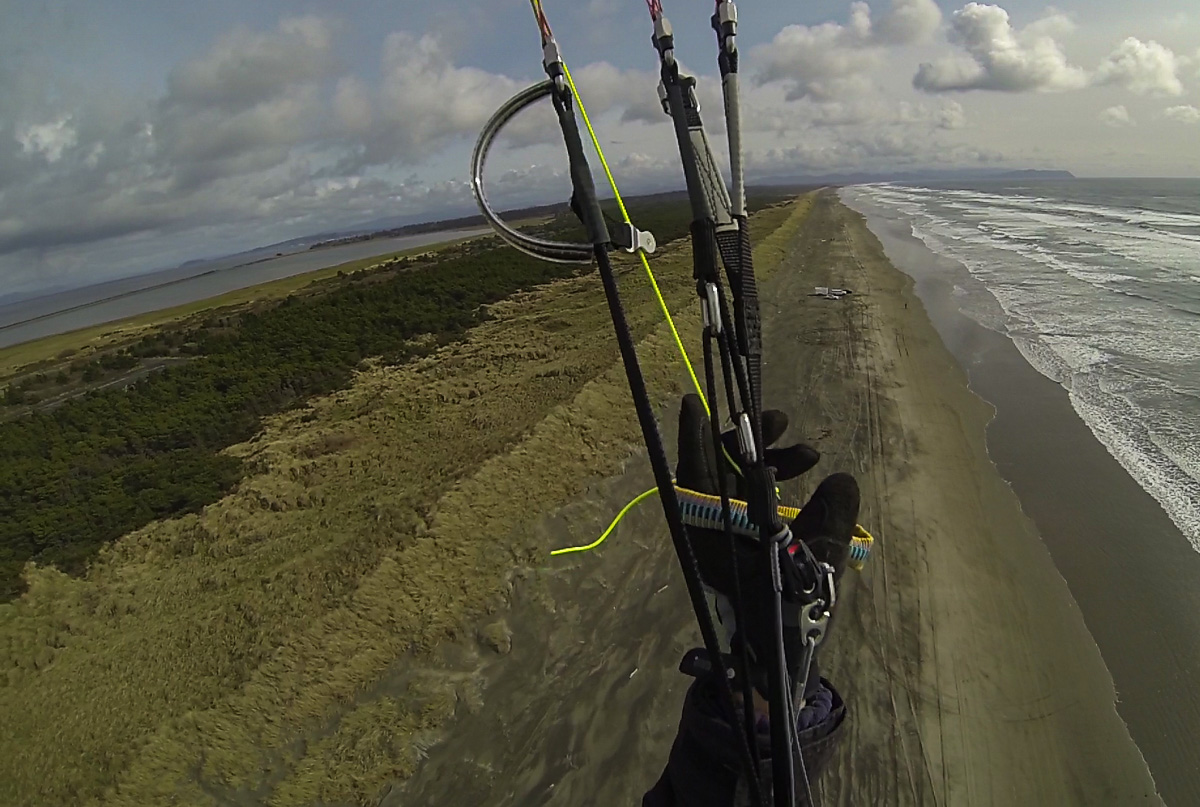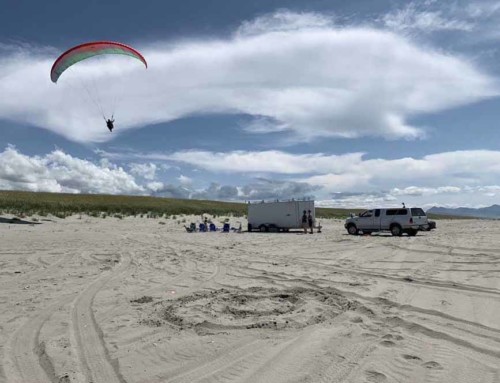I’m not sure if it’s public knowledge yet or not, but there was a broken leg accident at Area B recently. A mini-wing, strong winds, and a ‘too far back’ approach caused a hard top landing, resulting in a broken fibula. Everything stayed inside, thankfully. (No criticism of the pilot involved at all. He will share more details as he feels it’s appropriate.)
The accident got me thinking and wanting to share that there are things about Area B, or any very short coastal site, that are different than any other site. Sometimes critically different. Consider that Area B, at its highest point, is less than 30’ high!) Most of the differences are like second nature to us locals by now, but after this accident, I begin to realize that many of the things we see without even looking, may not be common knowledge to visiting pilots and those not as familiar with the site as we are with our backyard flying site.
I am going to focus mostly on Rotor turbulence and how it affects the different glider types for the bulk of this hopefully short article…
First, a little geometry: If you look at a mini wing vs. a regular wing, you’ll first notice that the glider is smaller. Duh. If you think about it further, you’ll notice that the lines are shorter. Considerably shorter. My math from a Delta 4 ML to a Zero 17 was 2.069 meters shorter (Or about 7’). I asked Maren how much shorter she thought the Zero 17 would be and she offhandedly suggested about 30% shorter. (She missed it by 11 millimeters! Ha!) This 30% size difference on a hill of more than 100’ high has a negligible effect, but at sites like Area B, it can make a significant difference!
Next, we should talk about the structure of the Rotor. When the wind is good for full size wings, the rotor tends to ‘lay low’ over the top of the dune. Anyone who has flown with me on the dune will usually notice when we’re passing that I will normally fly on the inside, far enough back that it is obvious that ‘right of way’ is ceded to the oncoming pilot, regardless of the ridge rules. I do this as a courtesy to visiting or student pilots. Give them room to stay in the lift band, so I get to enjoy watching them have fun! (In stronger winds, I’ll move out and play low at beach level instead…)
What isn’t obvious when I’m flying behind is that I am constantly evaluating the ‘thickness’ of the rotor. I’ll fly back far enough to just start to sense the ‘feather duster’ feel of the rotor on my face. At that point, I know I can’t go back any farther without risking putting the wing into the rotor too. (That could be bad. Embarrassing at a minimum!)
Now, on to the mini-wing problem. Even in identical conditions as a full-size wing, you are still going to be 7’ higher over the sand when your wing enters the turbulence. Now, somewhat obviously, mini-wings need more wind to soar. This stronger wind has the direct effect of ‘thickening’ the rotor zone. Now, when trying to top land, you not only have a wing with shorter lines, but a rotor that is so thick that you will be even farther from the ground when your wing gets affected by the turbulence. Downwash, plummetage, and something much better described as an ‘arrival’ rather than a landing.
Some recommendations for avoiding rotor splat at Area B.
1. Land close to the front.
2. Don’t approach from far behind.
3. Learn to feel the turbulence of the rotor on your face and use that data to figure out how far back is still safe for this day’s winds, even for this hour’s winds. NEVER count on conditions being like they were ‘yesterday’ or even ‘yester-hour’.
4. Consider all top landings as an attempt that you hope will result in a touchdown. STUDY your way into the top landing with multiple approaches. Eventually you’ll get it right. Don’t just decide to go land and NEVER force a top landing!
5. Consider alternatives, preferable even before you launch. Can I land on the beach? (The day of the recent accident, beach landing was a bad idea.) No on the beach? Ok, how about on the front of the dune instead of the top?
An even better consideration would be going to an area with a smoother dune structure, or even somewhere less lifty. (South of Area A for example.)
How I rate the rotor dangers of our local dune:
Area B: Severe – due to the razorback nature of a lot of the dune. The rotor can hit you when you’re still high above the sand.
Area A: Moderate to low – depending on location. The most forgiving places to land are to the south of the trailhead.
Shipwreck Approach to Camp Rilea: Low – The flat top and rounded front significantly reduces any potential rotor risk. Winds may need to be stronger here to soar, but launching and landing are easier/safer.
Fortunately, Rotor is rarely hard edged, and, if you’re paying attention, can give you warning if you’re approaching it from above, or from the side as in other larger flying sites. Are you encountering strange, atypical turbulence? Check your wind direction and consider turning around! Rotor, aka – mechanical turbulence, is bad.
Chicken Flapping: This is a technique that I see too often and strongly recommend against. It’s where an audible ‘flap, flap, flap’ accompanies the landing approach. This causes the glider to lose air speed, descend more rapidly and need altitude to regain airspeed and recover if things go sideways, (or rather ‘go backwards’?). Consider dropping through a strong wind gradient or into Rotor like you will likely find here with low airspeed and high angle of attack? Accidentally stalling your glider at 10’ sucks. For those that have intentionally stalled their glider enough (25-50 times?) to instantly recognize that beginning slip into stall and can instinctively respond before mental thought processes can catch up may be OK with this technique. If you don’t have that skill, you ARE in danger.
IF YOU DO GET BLOWN BACK: Fly the glider to the softest landing you can manage, then become ‘the Jelly Blob’. Don’t reach out to try to stop. Allow yourself to fall over. Try to keep your appendages close to your body. Go for the drag, it will eventually stop, and you can collect your embarrassed and en-sanded-ass up and actually be able to walk yourself back to the front of the dune. Putting an arm or leg out to try to stop is a good way for the beach grass to grab hold of it and ‘do bad things to you’.
Stupid Brad Tricks:
Many of you have seen the old video of me flying at Area B at King tide. It was great fun, but it should be shared that I had been waiting for that day for over 6 years. I would take every opportunity to learn how to nail the ‘worst case scenario’ landing and perfect my top landing skills at this site. On the day of the flight, I had firmly decided that a downwind landing on the face of the dune would be my worst-case solution, as landing on the beach was an extremely bad idea. Still one of my favorite flights. But in this case, I might suggest for most of you to ‘do as I say and not as I do’. It’s only in hindsight that I can see how much effort I put in to being ready for that day. The ocean can be evil and deserves our respect.
Here’s the video in question if you haven’t seen it. Also flown on a Zero 17. (Check out the second half for the low tide portion of the day.) Such a super fun day.
Hope this helps. Area B is an awesome teacher of precision flying, and it’s what Maren and I call ‘grins and giggles’ flying. The site can be unforgiving at times though.


